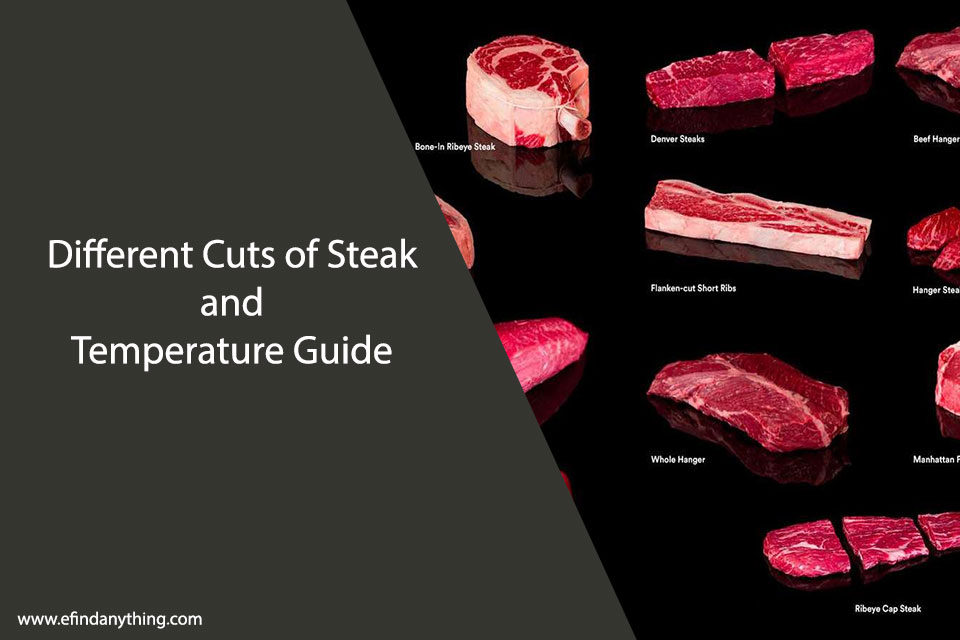
Cooking the perfect steak is an art that combines choosing the right cut, applying the right seasoning, and achieving the ideal temperature. Whether you prefer a tender filet mignon or a marbled ribeye, understanding the unique characteristics of each cut is essential. Using tools like a wireless meat thermometer ensures that your steak is cooked to perfection, with precise control over doneness.
In this article, we’ll explore popular steak cuts, their cooking methods, and a temperature guide to help you achieve mouthwatering results every time.
Popular Cuts of Steak and Their Characteristics
Each cut of steak comes from a specific part of the cow, offering unique flavors, textures, and cooking requirements. Here are some of the most popular cuts and what makes them special:
1. Ribeye Steak
- Characteristics: Known for its rich marbling, the ribeye is tender, juicy, and packed with flavor. The marbling melts during cooking, enhancing its succulence.
- Best Cooking Method: Ideal for grilling or pan-searing, the ribeye benefits from high heat to create a crispy crust while maintaining a juicy interior.
- Perfect Doneness: Medium-rare to medium allows the marbling to fully render.
2. Filet Mignon
- Characteristics: Cut from the tenderloin, filet mignon is prized for its buttery tenderness and mild flavor. It has minimal fat and is considered a luxurious choice.
- Best Cooking Method: Pan-searing followed by oven roasting works well. A quick sear locks in juices, and gentle heat finishes the steak evenly.
- Perfect Doneness: Rare to medium-rare preserves its delicate texture.
3. New York Strip
Characteristics: This cut offers a balance of tenderness and flavor, with a good amount of marbling but less fat than the ribeye.
- Best Cooking Method: Grill or sear on high heat for a beautiful crust and rich flavor.
- Perfect Doneness: Medium-rare to medium highlights its natural juiciness.
4. T-Bone and Porterhouse
- Characteristics: These cuts feature two steaks in one—a strip steak on one side of the bone and a tenderloin on the other. The porterhouse is larger, with more tenderloin.
- Best Cooking Method: Grilling is the top choice, as the bone adds flavor and helps retain moisture.
- Perfect Doneness: Medium-rare ensures both sides cook evenly without overcooking the tenderloin.
5. Sirloin
- Characteristics: A leaner cut with a robust, beefy flavor, sirloin is versatile and more affordable than other premium cuts.
- Best Cooking Method: Grill, broil, or pan-sear. Marinating can enhance its tenderness.
- Perfect Doneness: Medium to medium-well works best, as overcooking can make it tough.
6. Flank and Skirt Steak
- Characteristics: These cuts are thin, lean, and full of beefy flavor. They’re best when sliced against the grain to maximize tenderness.
- Best Cooking Method: Quick searing or grilling over high heat is ideal. They’re also great for marinades.
- Perfect Doneness: Medium-rare to medium keeps these cuts tender.
Why Temperature is Key to Cooking Steak
Achieving the right temperature is essential for a perfectly cooked steak. Overcooking can result in dryness, while undercooking may leave the steak cold and unappetizing in the center. A meat thermometer ensures precision by providing accurate readings in real-time.
Benefits of a Meat Thermometer:
- Precision: Eliminates guesswork by offering exact temperature readings.
- Convenience: Allows you to quickly check the various temps of the meat.
- Versatility: Suitable for various cooking methods, including grilling, roasting, and pan-searing.
Steak Temperature Guide
Here’s a quick reference for steak doneness and internal temperatures:
- Rare: 120°F–125°F (49°C–52°C)
- Cool, red center with a soft texture.
- Best for cuts like filet mignon or sirloin.
- Medium-Rare: 130°F–135°F (54°C–57°C)
- Warm, red center with a slight pink gradient.
- Perfect for ribeye, New York strip, and T-bone.
- Medium: 140°F–145°F (60°C–63°C)
- Warm, pink center with more firmness.
- Ideal for sirloin and marbled cuts.
- Medium-Well: 150°F–155°F (66°C–68°C)
- Slightly pink center with a firm texture.
- Best for lean cuts like flank or skirt steak.
- Well-Done: 160°F+ (71°C+)
- No pink, fully cooked through.
- Suitable for personal preference but may dry out certain cuts.
Tips for Cooking the Perfect Steak
- Bring to Room Temperature: Let the steak sit at room temperature for 30 minutes before cooking. This ensures even cooking.
- Season Generously: Use salt, pepper, and any additional seasonings or rubs to enhance flavor.
- Preheat Your Cooking Surface: Whether grilling or pan-searing, a hot surface is essential for creating a flavorful crust.
- Use a Meat Thermometer: Insert the probe into the thickest part of the steak for an accurate reading.
- Rest Before Serving: Let the steak rest for 5–10 minutes after cooking. This allows the juices to redistribute, resulting in a tender, flavorful bite.
- Slice Correctly: Always cut against the grain to maximize tenderness, especially for lean cuts like flank or skirt steak.
Common Mistakes to Avoid
- Overcooking: Using a thermometer prevents overcooking, which can make steaks dry and tough.
- Underseasoning: Proper seasoning enhances the steak’s natural flavor.
- Skipping Rest Time: Cutting into the steak immediately after cooking causes juices to escape, reducing its succulence.
Conclusion
Cooking the perfect steak starts with choosing the right cut and understanding its unique characteristics. By combining these insights with precise temperature control using a wireless meat thermometer, you can elevate your steak-cooking skills and consistently deliver restaurant-quality results.
Whether you prefer a rare filet mignon or a medium-rare ribeye, mastering the art of steak preparation will delight your guests and satisfy your taste buds. With the right tools and techniques, every steak you cook can be a masterpiece.
